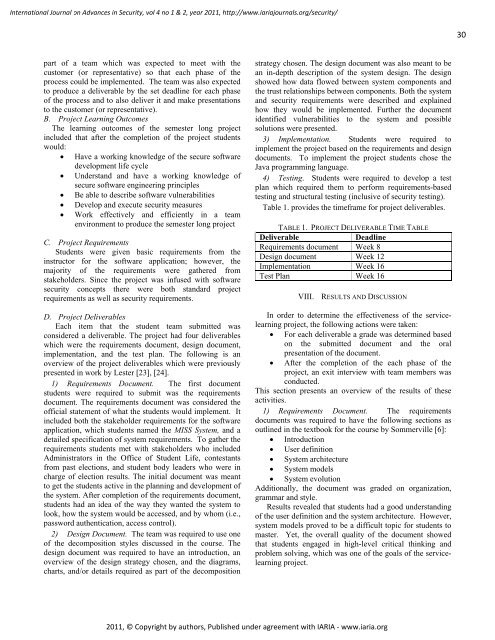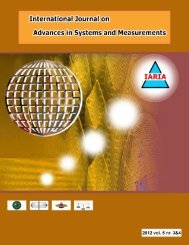Fault Tolerance Framework using Model-Based - IARIA Journals
Fault Tolerance Framework using Model-Based - IARIA Journals
Fault Tolerance Framework using Model-Based - IARIA Journals
You also want an ePaper? Increase the reach of your titles
YUMPU automatically turns print PDFs into web optimized ePapers that Google loves.
International Journal on Advances in Security, vol 4 no 1 & 2, year 2011, http://www.iariajournals.org/security/<br />
part of a team which was expected to meet with the<br />
customer (or representative) so that each phase of the<br />
process could be implemented. The team was also expected<br />
to produce a deliverable by the set deadline for each phase<br />
of the process and to also deliver it and make presentations<br />
to the customer (or representative).<br />
B. Project Learning Outcomes<br />
The learning outcomes of the semester long project<br />
included that after the completion of the project students<br />
would:<br />
• Have a working knowledge of the secure software<br />
development life cycle<br />
• Understand and have a working knowledge of<br />
secure software engineering principles<br />
• Be able to describe software vulnerabilities<br />
• Develop and execute security measures<br />
• Work effectively and efficiently in a team<br />
environment to produce the semester long project<br />
C. Project Requirements<br />
Students were given basic requirements from the<br />
instructor for the software application; however, the<br />
majority of the requirements were gathered from<br />
stakeholders. Since the project was infused with software<br />
security concepts there were both standard project<br />
requirements as well as security requirements.<br />
D. Project Deliverables<br />
Each item that the student team submitted was<br />
considered a deliverable. The project had four deliverables<br />
which were the requirements document, design document,<br />
implementation, and the test plan. The following is an<br />
overview of the project deliverables which were previously<br />
presented in work by Lester [23], [24].<br />
1) Requirements Document. The first document<br />
students were required to submit was the requirements<br />
document. The requirements document was considered the<br />
official statement of what the students would implement. It<br />
included both the stakeholder requirements for the software<br />
application, which students named the MISS System, and a<br />
detailed specification of system requirements. To gather the<br />
requirements students met with stakeholders who included<br />
Administrators in the Office of Student Life, contestants<br />
from past elections, and student body leaders who were in<br />
charge of election results. The initial document was meant<br />
to get the students active in the planning and development of<br />
the system. After completion of the requirements document,<br />
students had an idea of the way they wanted the system to<br />
look, how the system would be accessed, and by whom (i.e.,<br />
password authentication, access control).<br />
2) Design Document. The team was required to use one<br />
of the decomposition styles discussed in the course. The<br />
design document was required to have an introduction, an<br />
overview of the design strategy chosen, and the diagrams,<br />
charts, and/or details required as part of the decomposition<br />
strategy chosen. The design document was also meant to be<br />
an in-depth description of the system design. The design<br />
showed how data flowed between system components and<br />
the trust relationships between components. Both the system<br />
and security requirements were described and explained<br />
how they would be implemented. Further the document<br />
identified vulnerabilities to the system and possible<br />
solutions were presented.<br />
3) Implementation. Students were required to<br />
implement the project based on the requirements and design<br />
documents. To implement the project students chose the<br />
Java programming language.<br />
4) Testing. Students were required to develop a test<br />
plan which required them to perform requirements-based<br />
testing and structural testing (inclusive of security testing).<br />
Table 1. provides the timeframe for project deliverables.<br />
TABLE 1. PROJECT DELIVERABLE TIME TABLE<br />
Deliverable Deadline<br />
Requirements document Week 8<br />
Design document Week 12<br />
Implementation Week 16<br />
Test Plan Week 16<br />
VIII. RESULTS AND DISCUSSION<br />
In order to determine the effectiveness of the servicelearning<br />
project, the following actions were taken:<br />
• For each deliverable a grade was determined based<br />
on the submitted document and the oral<br />
presentation of the document.<br />
• After the completion of the each phase of the<br />
project, an exit interview with team members was<br />
conducted.<br />
This section presents an overview of the results of these<br />
activities.<br />
1) Requirements Document. The requirements<br />
documents was required to have the following sections as<br />
outlined in the textbook for the course by Sommerville [6]:<br />
• Introduction<br />
• User definition<br />
• System architecture<br />
• System models<br />
• System evolution<br />
Additionally, the document was graded on organization,<br />
grammar and style.<br />
Results revealed that students had a good understanding<br />
of the user definition and the system architecture. However,<br />
system models proved to be a difficult topic for students to<br />
master. Yet, the overall quality of the document showed<br />
that students engaged in high-level critical thinking and<br />
problem solving, which was one of the goals of the servicelearning<br />
project.<br />
2011, © Copyright by authors, Published under agreement with <strong>IARIA</strong> - www.iaria.org<br />
30







